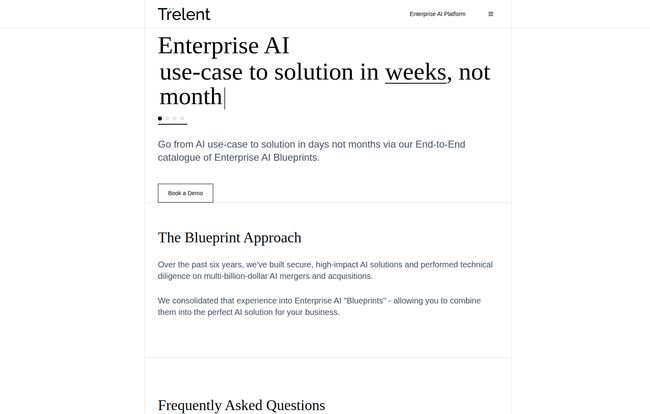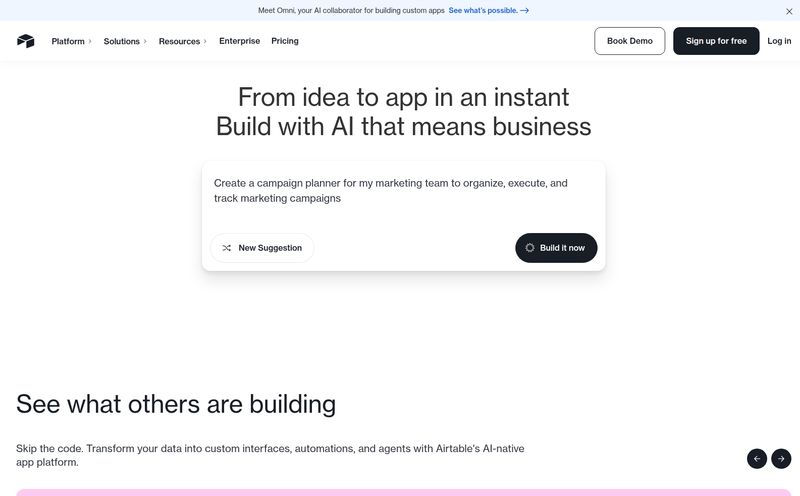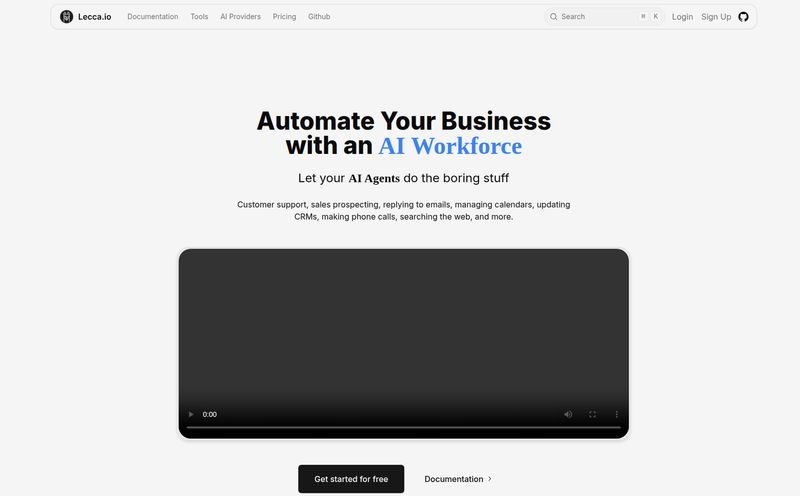As someone who’s been swimming in the digital marketing and SEO soup for years, I’ve seen trends come and go. But the AI explosion? This one’s different. It feels less like a trend and more like a tectonic shift. Every other company is slapping an "AI-powered" sticker on their product, promising to revolutionize your workflow with a generic chatbot that, let's be honest, is often just a fancy wrapper for an API call.
We've all been there. You sign up for a new tool, excited by the promise of artificial intelligence, only to find it’s clunky, doesn't quite fit your use-case, and—the scariest part—you have no idea where your company’s sensitive data is actually going. It's a bit of a mess. That’s why when I stumbled upon a company called Trelent, my curiosity was piqued. They aren’t selling another one-size-fits-all gadget. Their whole pitch is different. They build custom, secure AI solutions, and they claim to do it in weeks, not months. A bold claim, for sure. So, is it for real?
What Exactly is Trelent, Anyway?
Think of it this way. Most AI tools on the market are like buying a suit off the rack. It might mostly fit, but the shoulders are a bit tight, the sleeves are too long, and it's just not you. Trelent is the bespoke tailor. They don’t hand you a pre-made product; they work with you to build a solution that's designed from the ground up for your specific business needs.
They do this through something they call “Enterprise AI Blueprints.” Now, I know what you're thinking. Another piece of marketing jargon. I was skeptical too. But the idea behind it is actually pretty solid. Instead of starting from absolute scratch every single time, they use a catalogue of pre-developed, secure components—the “blueprints”—and combine them to create the perfect AI solution for your business. It's less like building a car from a pile of raw metal and more like having a garage full of high-performance engines, chassis, and security systems ready to be assembled into your dream car.
The "Blueprint Approach": Why It's Not Just Fluff
The biggest pain point with any custom development, AI or otherwise, is the timeline. It can drag on for months, even years. The budget balloons, stakeholders get antsy, and by the time it's ready, the tech might already be outdated. It’s a nightmare I've seen play out too many times with clients.
Trelent’s promise to go from “use-case to solution in weeks, not months” directly attacks this problem. Their blueprint model is the key. By leveraging their six-plus years of experience in building secure AI and doing technical diligence for massive M&A deals, they’ve essentially created a set of proven, repeatable patterns. This means they're not reinventing the wheel with every new client. They’re just choosing the right wheels and building the perfect vehicle around them, for you.

Visit Trelent
This accelerates everything. The discovery phase is shorter because you’re working with established concepts. The development is faster because the foundational blocks are already built and tested. And the deployment is smoother because they’ve done it all before. It’s a smart way to offer customization without the crippling timelines. This isn't just theory; its a practical approach to a very common business bottleneck.
Security First, Because Your Data Isn't a Public Commodity
Now, let's talk about the thing that should keep every business owner up at night: data privacy. In the gold rush to implement AI, a lot of companies are casually feeding proprietary information into third-party models without a second thought. It's a massive risk, especially for anyone in regulated industries like finance, healthcare, or law.
This is where Trelent plants its biggest flag. One of their core features is Zero Data Retention (ZDR). This is a huge deal. It means that when your data is processed by their AI solution, it’s not stored or logged on their systems. It’s processed, the result is returned, and then it’s gone. Poof. They don't use your data to train their models. They don't keep it for… well, who knows what other companies keep it for. Your data remains your data. Full stop.
In an age where data breaches are a weekly headline, this focus on building a secure, private AI environment is, in my opinion, their most compelling feature. It transforms AI from a potential liability into a secure asset.
Who Is Trelent Actually For? (And Who It's Not For)
I’ve always felt that the best tools aren’t for everyone. A tool that tries to please everybody often ends up pleasing nobody. Trelent seems to understand this.
This is probably a great fit for you if:
- You're in a regulated industry and data security is non-negotiable.
- You have a very specific use-case that off-the-shelf products just can't handle.
- Your company needs to deploy a high-impact AI solution fast, without cutting corners on security or quality.
- You already have an AI team, but they're bogged down, and you need to accelerate deployment with a trusted partner.
You might want to look elsewhere if:
- You're a solopreneur or a very small team looking for a simple, cheap AI writing assistant.
- You prefer a simple, plug-and-play tool with a monthly subscription and no human interaction.
- The phrase “Book a Demo” on a pricing page gives you hives.
The Elephant in the Room: Trelent's Pricing
So, you go to their website, and there's no pricing page. Just a friendly “Book a Demo” button. I can hear the collective groan. But let’s pause for a second. Why do companies do this? In this case, it makes sense. Trelent isn’t selling a product with three neat tiers. They’re selling a custom service. The cost to build a simple internal Q&A bot is going to be wildly different from the cost of deploying a complex, multi-faceted AI for analyzing financial documents across an entire enterprise.
Putting a price tag on that would be impossible. This is a “you get what you pay for” scenario. It’s not a $20/month tool. It’s a strategic investment in your company’s infrastructure. So while the lack of transparency can be frustrating for window shoppers, it's standard practice for bespoke enterprise services.
Trelent vs. Just Using the OpenAI API
This is a fair question, and one they even address in their own FAQ. “Why not just have our engineers build on the OpenAI or Claude API directly?” You could. Absolutely. But that’s like saying, “Why hire a master chef when I can just buy flour, eggs, and sugar?”
Using an API gives you the raw ingredient. Trelent is the entire kitchen and the Cordon Bleu-trained chef. They are building the infrastructure, the security protocols, the user interface, the data pipelines, and the whole end-to-end solution around that raw ingredient. They are handling the deployment, the maintenance, and ensuring it all works securely within your environment. It’s the difference between a DIY project and a professionally architected and constructed system.
Frequently Asked Questions (and My Honest Answers)
What's the real difference between using Trelent and just calling the OpenAI or Claude API?
Think of it as raw power vs. a finished product. The API gives you access to the engine. Trelent builds the entire secure, high-performance car around it for you, complete with a dashboard, navigation, and anti-theft system tailored to your exact needs.
We already have an in-house AI team. Why would we need Trelent?
Even the best teams can get stuck. Trelent can act as an accelerator. Their Blueprints can save your team months of foundational work, freeing them up to focus on the more nuanced, business-specific parts of the project. It's about augmenting your team, not replacing it.
Is Zero Data Retention (ZDR) really that important?
In a word: yes. Absolutely. If you're handling any kind of client, financial, or proprietary data, ZDR is your best friend. It significantly reduces your security risk and is often a requirement for compliance in major industries. Not taking it seriously is a gamble I wouldn't want to make.
How custom are these "custom" solutions?
From what I can gather, it's highly custom. The “Blueprints” are the starting point, not the final product. The goal is to combine and configure them to solve a specific business problem, which means the final solution is unique to the client.
Do I have to bring my own Large Language Model (LLM)?
Their FAQ suggests they are model-agnostic. This is great because it means they can choose the best LLM for your specific job (whether it’s from OpenAI, Anthropic, Google, or a smaller, specialized model) and offer different deployment options. You're not locked into one ecosystem.
So, what's the catch with the pricing?
The “catch” is that it’s not for bargain hunters. It's enterprise-level custom development, and it will be priced accordingly. The value proposition is a faster, more secure deployment than building from scratch, which could save you more money in the long run.
My Final Take on Trelent
In a sea of AI me-too products, Trelent is taking a refreshingly different tack. They’re not for everyone, and they’re not trying to be. They are focused on a specific, and very important, segment of the market: businesses that need powerful, custom AI but cannot—and should not—compromise on security or speed.
The Blueprint approach is a genuinely clever way to solve the classic “time vs. customization” dilemma. If your organization is serious about implementing AI and understands that it's a strategic investment, not just a monthly expense, then Trelent is definitely a name you should know. They represent a more mature, thoughtful approach to AI integration. It’s a “measure twice, cut once” philosophy in a world that’s all too often just cutting corners.



